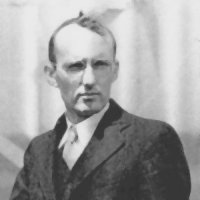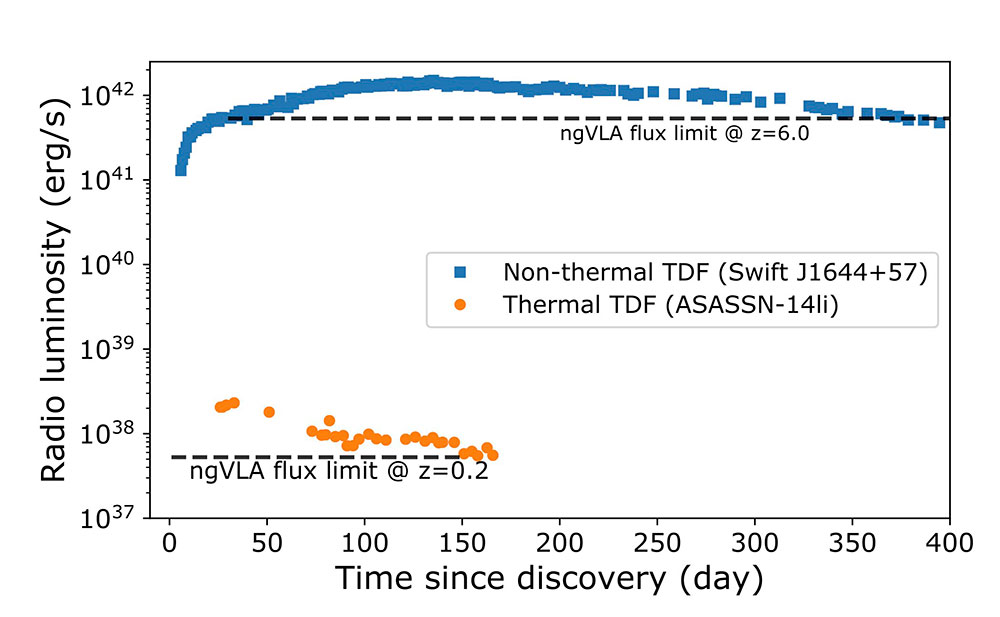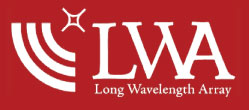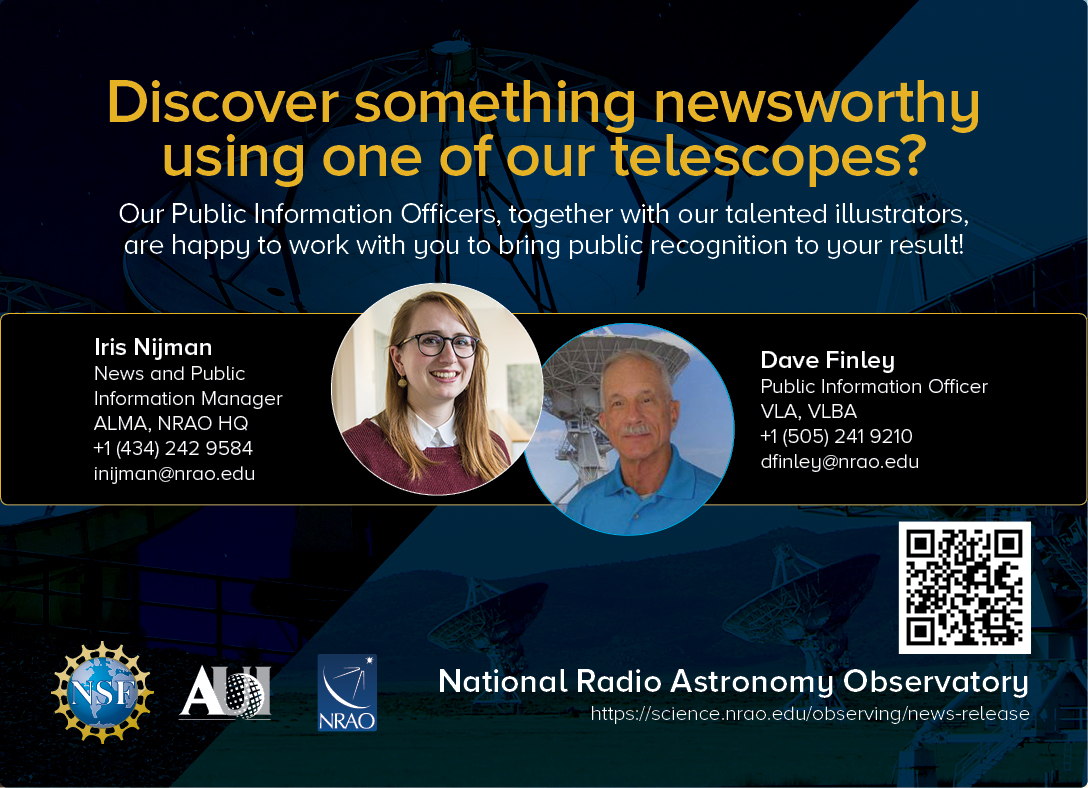NRAO eNews
Volume Vol#, Issue Iss#
Day# Month# Year#
NRAO eNews
Volume Vol#, Issue Iss# • Day# Month# Year#

Upcoming Events

ALMA Virtual Town Hall
Oct 2, 2020 | Virtual

The ALMA 2030 Vision: Design considerations for Digitizers, Backend and Data Transmission System
Oct 14 - 16, 2020 | Virtual

NRAO Town Hall
Jan 13, 2021 | Virtual AAS Meeting

New Views of Galaxy Formation and Evolution
Jan 14, 2021 | Virtual AAS Meeting

8th VLA Data Reduction Workshop
Mar 15 - Apr 1, 2021 | Virtual
2021 Jansky Fellowship Program

The Jansky Fellowship Program supports outstanding postdoctoral scientists and engineers whose research is broadly related to the mission of the National Radio Astronomy Observatory (NRAO). NRAO enables forefront research into the Universe at radio wavelengths. In partnership with the scientific community, we provide world-leading telescopes, instrumentation, and expertise, train the next generation of scientists and engineers, and promote astronomy to foster a more scientifically literate society. NRAO operates three world-class research facilities: the Atacama Large Millimeter/submillimeter Array, the Very Large Array, and the Very Long Baseline Array. We welcome applicants who bring diverse and innovative dimensions to the Observatory and to the field of radio astronomy.
As a Jansky Fellow, you will have a unique opportunity to contribute to and learn from the development and delivery of the largest and most capable radio telescopes in the world. Candidates with interests in radio astronomy techniques, multi-wavelength collaborations, instrumentation, computation, theory, and education/public outreach are encouraged to apply. Applicants should describe how their research or technical interests couple with NRAO’s mission, telescopes or science.
Appointments may be made at either of the NRAO sites: Socorro, NM, or Charlottesville, VA. In some cases, a ‘split appointment’ Jansky Fellowship split between a university and an NRAO site, or a ‘non-resident’ Jansky Fellowship hosted at a university within the United States may be offered. Regardless of appointment type, remote work arrangements may also be considered to accommodate limitations due to COVID-19. Non-resident Jansky Fellows are encouraged to develop a research program that fosters close ties with the NRAO, and should present a strong case why residence at their proposed host university will accomplish this. They are also strongly encouraged to make frequent and/or long-term visits to NRAO sites during their Fellowship.
All Jansky Fellows are expected to spend at least 75% of their time on self-directed research. Jansky Fellows also have the opportunity to spend 10-25% of their Fellowship engaging with Observatory staff on activities related to the development and delivery of radio astronomy techniques, capabilities, or education/public outreach activities, to develop their own broad skill set and enhance NRAO’s broader impact goals.
The NRAO Jansky Fellowship Program provides numerous opportunities for early career scientists and engineers to acquire a deep knowledge and understanding of the state-of-the-art in radio astronomy science and instrumentation to establish themselves as innovative, independent research scientists and engineers. Jansky Fellows are encouraged to develop research collaborations with NRAO scientific staff, scientists at U.S. universities, and their colleagues in the international astronomical or instrumentation community. An annual, multi-day NRAO Postdoctoral Symposium fosters collaboration between Jansky Fellows and the Observatory’s scientific staff.
The starting salary for the 2021 Jansky Fellowship program will be $68,500 for an initial two-year appointment with possible renewal for a third year. A research budget of up to $17,000 per year is provided for travel and computing support. Fellows are also eligible for page charge support, vacation accrual, health insurance, and a relocation allowance. NRAO can provide up to $3,000 per year to non-NRAO host institutions to defray local institutional expenses.
The deadline for 2021 Jansky Fellowship Program application materials, including letters of reference, is Monday, November 2, 2020 at 11:59 pm EDT. Award offers will be made starting in early January 2021. Fellowships normally begin in September 2021.
More information about the Jansky Fellowship Program and instructions on how to apply, are available online. Questions or assistance with the application procedure, as well as requests for additional information on the Jansky Fellowship Program may be sent to Jansky2021@nrao.edu.
NRAO is an equal opportunity employer.
8th VLA Data Reduction Workshop: 1st Announcement

The NRAO is pleased to announce the 8th VLA Data Reduction Workshop, which will be held virtually 15 March–1 April 2021.
The main goal of this Workshop is to assist observers with the challenges of Very Large Array (VLA) data reduction posed by the increased flexibility and complexity of the instrument. We will provide lectures on key topics and allow participants to reduce and image their own data while local expert staff members are available online for consultation.
Please note that this is an advanced Workshop and, unlike our summer Synthesis Imaging Workshops, is not intended for those who are new to radio interferometry. Prior experience with AIPS, CASA, or MIRIAD is required. As we will be using CASA for data reduction, a working knowledge of it would be helpful; we strongly recommend those new to CASA to go through one or more of our tutorials prior to attending the workshop.
Unlike previous VLA data reduction workshops, this event will span almost three weeks. The first week will include lectures and dedicated time for data reduction and imaging. The optional second and third weeks will be devoted primarily to data reduction and imaging of each participant's data.
A web page announcing Workshop details–program, logistics for virtual participation, etc.–will go live and be advertised in the coming months, and will include an online registration form. There is no registration fee to attend the Workshop. However, the event will be limited to 30 participants, so please register early to reserve your spot.
ngVLA Project News

Two Virtual Science Series Available for Viewing
The next generation Very Large Array (ngVLA) project recently sponsored two virtual science talk series that are available for online viewing.
A virtual Multi-Messenger Mini-Conference was held 14-15 July 2020. Its recorded presentations and Q&A sessions covered topics pivotal to the future of multi-messenger astronomy. Presenters focused on current progress, future directions, and how to best use the suite of multi-messenger facilities through the 2020s and beyond. The presenter lineup was primarily organized by Nicole Lloyd-Ronning (Los Alamos) and Tom Maccarone (Texas Tech). Over 850 individuals, predominantly graduate students, registered. Almost 650 individuals representing 40+ countries attended one or both days. The conference presentations have already accrued 150+ views.
A weekly virtual ngVLA Summer Short Talk Series ran 25 June–10 September 2020. The recorded presentations and Q&A exchanges discussed key science questions and their connection to present and future observing facilities at all wavelengths. The presenter lineup was organized by the ngVLA Science Advisory Council, led by co-chairs Alberto Bolatto (Maryland) and Andrea Isella (Rice). A total of 768 individuals from 47 countries attended one or more presentations. The average attendance at each meeting included over 200 participants, ranging between 150-380, and represented well over 100 institutions. A large percentage of participants were graduate students. As of 13 September 2020, there were over 817 additional views of the talks online.
While the pandemic has blocked our ability to host in-person meetings, the pivot to virtual meetings has enabled us to engage a larger, more diverse global audience. The recordings of these virtual events provide a lasting legacy for the scientific community and the public.
New Views of Galaxy Formation and Evolution
The NRAO will convene a virtual Special Session titled New Views of Galaxy Formation and Evolution on 14 January 2021 at the American Astronomical Society (AAS) meeting.
Sensitive ground- and space-based astronomical facilities are pushing the detection of galaxies well into the Epoch of Reionization (EoR), less than 1 Gyr after the Big Bang. Such observations are allowing us to begin piecing together a picture for how and when the first galaxies formed, along with the physical processes driving their evolution into the mature systems that we observe in the local Universe.
While existing facilities are making transformative discoveries by pushing their capabilities to the limit of what can be detected at the earliest times, sample sizes remain small as detections of individual systems are limited to the most luminous sources or those whose detections are afforded by strong lensing. Informed by these pioneering efforts, suites of next-generation ground- and space-based facilities will marshal a new combination of large area, deep multi-wavelength surveys that will jointly characterize the accretion, star formation, molecular gas, and stellar mass histories for large populations of galaxies back into the EoR and beyond. When combined with a detailed accounting of the kinematics, chemical abundances, and energetic processes associated with these systems, such studies will ultimately provide a self-consistent framework that will revolutionize the field of galaxy evolution, leading to a much-improved theoretical understanding of the fundamental physics driving the formation and evolution of galaxies over cosmic time.
This AAS Special Session will highlight recent scientific breakthroughs in galaxy evolution enabled by current investigations using large optical/IR, (sub-)millimeter, and radio facilities; describe planned near- and long-term improvements for ground- and space-based facilities; discuss major scientific leaps likely to result from next-generation facilities across the electromagnetic spectrum; and review the highest-priority themes in the field of galaxy evolution that will be accomplished by the state-of-the-art observatories commissioned in the next decade. This Special Session will feature a session of invited oral presentations and an associated iPoster session with contributed presentations.
Confirmed speakers include: Mark Dickinson (NOIRLab), Linda Tacconi (Max Planck Institute for Extraterrestrial Physics), Justin Spilker (University of Texas), Xiaohui Fan (University of Arizona), Chris Willott (Herzberg Astrophysics), and Rachel Sommerville (Flatiron Institute).
We encourage you to consider contributing to the associated iPoster session. When submitting a contributed iPoster abstract to the AAS, you will have the option of requesting that your iPoster be included in this Special Session. iPoster abstracts are due 13 October 2020.
ngVLA & Newly-formed Jets

Radio light curves (15 GHz) for two archetype radio-loud and radio-quiet TDEs, with the maximum redshifts for detections in a single ngVLA snapshot observation indicated (V18).
[click to enlarge]
A star that passes too close to a supermassive black hole will be tidally disrupted, leading to a spectacular multi-wavelength transient. The transient radio emission from these tidal disruption events (TDEs) has yielded many surprising results that have been used to study black holes and the inner parsec of their host galaxy (C20, A20).
In 2011, relativistic jets following a TDE were discovered (Z11, B11). Remarkably, the luminous radio emission from this jet will remain detectable for decades (E18). Since 2011, radio observations with the VLA of TDEs found via their soft X-ray or optical emission yielded no detections (B13, V13). Finally, in 2016, we obtained the first detection of radio emission from a TDE that was found by its optical emission (V16, A16). Surprisingly, the radio emission for this event was orders of magnitude fainter than the powerful jetted TDEs.
To date, the origin of radio emission from these radio-quiet TDEs remains unknown. Some evidence suggests this radio emission is also due to a jet (P18). In that case, we are forced to explain an enormous range of TDE jets. Since for each TDE about the same amount of mass (i.e., one star) is available to power these jets, this range of power puts a challenging constraint on models of black hole jet formation. Radio observations of TDEs can thus be used to reveal the “hidden variable” that triggers the creation of powerful jets from accreting black holes. A high black hole spin is often considered essential for powerful jets (e.g., T13), but this idea is challenged by X-ray observations of the archetypal radio-quiet TDE (ASASSN-14li), which suggest that this black hole is rapidly spinning (P19). We conclude that TDEs have the potential to reveal the mechanism behind the creation of powerful jets, but the current sample remains too small.
Starting in November 2020, our VLA Large Program (PI: K. Alexander) will build toward the first statistical sample of TDEs with uniform radio observations. However, this sample will be sensitivity-limited to the local Universe. The majority of the thousands of TDEs that will be detected in the near future by the Vera C. Ruben Observatory will be too distant for follow-up with the VLA. The ngVLA will be essential to keep up with the growing detection rate of optical transients (see figure). In particular, frequency coverage at 5-50 GHz is important to resolve the peak of the spectral energy distribution, which is needed to measure the energy of the jets/outflows. Using large samples of TDEs with ngVLA follow-up observations, we will measure jet power as a function of accretion rate and black hole spin. This sample will provide an unprecedented opportunity to disentangle the variable that triggers the launch of powerful jets. The ngVLA is also sensitive and efficient enough to find radio TDEs in blind surveys, which can reveal a population of newly formed jets that have been missed at other wavelengths (e.g., M16).
Finally, for some lower-redshift events, Very Long Baseline Interferometry observations with the ngVLA will spatially resolve the newly-formed jets (M16). Witnessing the growth of jets in real-time is key to break degeneracies in synchrotron models (F99). Applying these synchrotron models to the observed radio spectra will yield a measurement of the gas density at the outflow end point, hence ngVLA observations will provide a robust probe of the gas density profile in the nuclei of quiescent galaxies.
This article continues a regular feature intended to highlight contributions to the ngVLA Science Book. We are especially interested in showcasing work done by early-career researchers. Anyone wishing to volunteer to author a feature should contact Joan Wrobel.
ALMA Operations Status

Occasional snowstorms may limit access to the Array Operations Site for short periods.
[click to enlarge]
Winter continues to grip the ALMA site, which remains shut down, monitored by a Caretaker team based in San Pedro, as conditions safely allow. Snowstorms occasionally limit access to the Array Operations Site (AOS) for short periods. With the arrival of austral spring, weather at the AOS will continue to improve.
Detailed plans for the safe return to ALMA operations have been developed and regular reviews to consider starting the re-opening process of the Observatory have begun. ALMA is still in the Caretaker phase, with small teams maintaining the safety of the ALMA equipment and infrastructure. As always, the top priority is the health and safety of all staff.
ALMA Virtual Town Hall - Friday, 02 October, 03:00 p.m. Eastern Time.
We have now passed the 6 month mark for many of us under various levels of quarantine and work-from-home situations and our thoughts continue to go out to those affected by the current global situation. Over the course of the past several weeks, several astronomical facilities are starting to open and accept proposals for upcoming observing seasons. ALMA has also started discussions and will update the community on the current situation in Chile and the plans going forward as we consider the safe return to operations.
To update everyone on the current state of operations at the North American ALMA Science Center (NAASC) and at the Joint ALMA Observatory (JAO) in Chile, an ALMA Virtual Town Hall will be held on Friday, 02 October, 2020 starting @ 15:00 EDT. We will start with a short presentation (15-20 min) on the current state of operations followed by a question and answer session. You can submit your questions early by sending an email to naascrec@nrao.edu with “ALMA Town Hall Question” in the Subject field. As many questions as possible will be answered either before or during the Town Hall.
Registration for the ALMA Virtual Town Hall is now open. And, as always, questions about the NAASC or ALMA can be submitted any time to the ALMA Helpdesk.
The ALMA 2030 Vision: Design considerations for Digitizers, Backend and Data Transmission System
The ALMA Development Roadmap has identified the increase of the IF bandwidth of ALMA (at least by a factor 2) as one of the main priorities for ALMA upgrades in the 2020s. This increase of the instantaneous bandwidth will be realized with the coordinated upgrade of receivers in the Front End, the correlators, and last but not least, all electronics between them: digitizers, backend and Data Transmission System (DTS). This virtual Workshop will be held on October 14-16, 2020. The Workshop aims to bring together experts on the ALMA system and digitizer, backend and data transmission system technologies, from within ALMA and from the community, to:
- discuss the status of technology and performance prospects for the next decade for digitizers, backend and DTS,
- identify the impact on these subsystems due to the increase of the instantaneous bandwidth by a factor >2,
- discuss the most suitable location of the 2nd generation ALMA correlators in relation with the status of DTS technologies,
- identify the possibility to use off-the-self technologies for the implementation of the 2nd generation of ALMA digitizers, backend and DTS,
- discuss possible system architectures to implement the multiplication of the IF bandwidth of ALMA by a factor >2.
Virtual f2f Visits to the NAASC are Open
Typically, the North American ALMA Science Center (NAASC) provides travel and lodging support for visits to NRAO headquarters in Charlottesville, Virginia by investigators of successful ALMA programs or archival researchers. During these unusual times, the NAASC is providing virtual face-to-face (f2f) visits. If you need help re-processing and/or analyzing your ALMA data, or data collected from the archive, or need that final push to finish writing your ALMA paper, consider a virtual face-to-face visit to work closely with NAASC data analysts and scientific staff.
Additional information regarding how to request a visit is online. Please submit a ticket to the face-to-face visits department of the ALMA Helpdesk.
ALMA Ambassadors
Applications for the 2021 ALMA Ambassadors program are now open. Please send a completed application form and a CV to naascrec@nrao.edu no later than 23 October 2020, 5 p.m. ET.
Redesigning the ALMA User Experience

It has been a while since ALMA antennas have pointed towards the sky. Many of you have used this time to mine the ALMA archive, do great science and contemplate your past experience with ALMA data and the services, tools, and user support offered since Cycle 0.
While the antennas are taking an unanticipated break, ALMA is launching a new global project to Redesign the User eXperience (RedUX). As part of RedUX we will establish focus groups to discuss specific aspects of the ALMA user experience. By volunteering to join a focus group, you can help shape the future of ALMA. If you are interested in contributing to RedUX (and in receiving a small gift at the end of the exercise, as a token of our appreciation for your contribution), please fill in this form. The form is not anonymous, as we need your contact details to be able to get in touch with you.
For more information, please contact George Privon.
LWA Radio Observatory: Cycle 9 Call for Proposals

We invite applications for observing time with the Long Wavelength Array (LWA) Radio Observatory. The complete call for proposals, including the required cover page, is available online. Proposers can request observations with LWA1, LWA-SV, or an interferometry mode between the two.
LWA1 offers up to three independently-steerable wide-band beams. Each beam supports two independent tunings over the LWA1 frequency range from 10 to 88 MHz with a FWHM ranging from 15 to 2 degrees. Each tuning can cover up to 20 MHz bandwidth. Two all-dipole modes are also available: a transient buffer narrow (TBN), and a transient buffer wide (TBW).
LWA-SV offers up to two beams with two tunings of 20 MHz each. The two tunings are dependent between the beams, and thus need to be at the same frequency. In addition, two all-dipole modes are available: a transient buffer narrow (TBN) and a transient buffer frequency domain (TBF).
For the interferometer mode, two beams are used at both LWA1 and LWA-SV: one for calibration and one for the target source. The correlation produces a fan-beam on the sky with a phase center that is affected by the ionosphere. The bandwidth available is 2 tunings of 20 MHz each. An online tutorial describes the observing setup and data reduction.
The deadline for applications is 11:59 p.m. Mountain Daylight Time on 30 October 2020 for observations expected in calendar year 2021. We invite proposals from all communities wishing to use this instrument.
Additional information about the LW1 capabilities are available on the LWA website. An introduction to using the LWA1 is available online. Questions regarding this call for proposals should be sent to lwa@unm.edu.
You Made a Discovery? We’ll Make It News!

[click to enlarge]
If you discover something newsworthy using one of NRAO’s telescopes, our Education and Public Outreach (EPO) department is happy to work with you to bring public recognition to your result.
Our writers and visualizers are skilled and experienced at interpreting science for the public. They’ll work with you directly to craft a story that will express the essence of your result in an accurate and approachable way. We have extensive distribution networks and an established reputation among science journalists as a dependable source of newsworthy stories.
Our Public Information Officers are your points-of-contact:
- For ALMA & NRAO HQ: Iris Nijman, Charlottesville – inijman@nrao.edu | +1-434-242-9584
- For VLA & VLBA: Dave Finley, Socorro – inijman@nrao.edu | +1-505-241-9210
More information and Frequently Asked Questions
Read previous NRAO press releases here
Recent Media Releases
|
NRAO Joins Space Mission to the Far Side of the Moon to Explore the Early Universe |
|
|
VLBA Makes First Direct Distance Measurement to Magnetar |
|
|
ALMA Discovers Misaligned Rings in Planet-Forming Disk Around Triple Stars |
|
|
IMAGE RELEASE: A Galaxy’s Stop-and-Start Young Radio Jets |
From the Archives
Ellen Bouton

[click to enlarge]
About this month's photo: Forty years ago, on 10 October 1980, employees, officials, and other dignitaries gathered at the Very Large Array site to dedicate the completed VLA. Although discussions on the concept of an antenna array had begun as early as 1955 (prior to NRAO's 1956 founding), formal planning for the Very Large Array began in the mid-1960s. Construction began in December 1972, and continued until the dedication.
This photo is from the VLA's 20th anniversary celebration on 23 August 2000, when NRAO Director Paul Vanden Bout presented commemorative golden spikes to (left to right) AUI Board member Anneila Sargent, AUI Board Chair Paul Martin, AUI President Riccardo Giacconi, NM Senator Pete Domenici, and NSF Director Rita Colwell.
From the Archives is an ongoing series illustrating NRAO and U.S. radio astronomy history via images selected from our collections of individuals' and institutional papers. If readers have images they believe would be of interest to the Archives, please contact Ellen Bouton.

